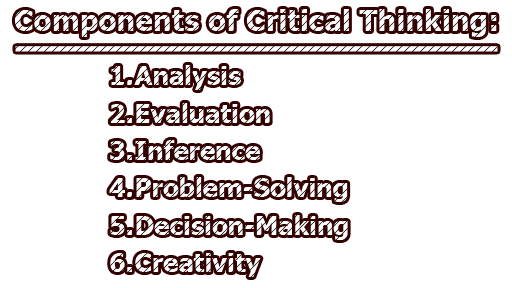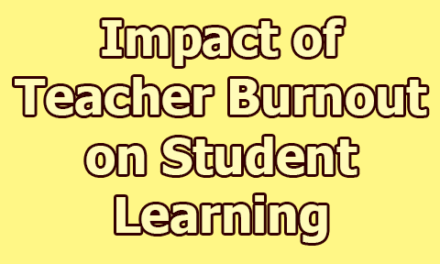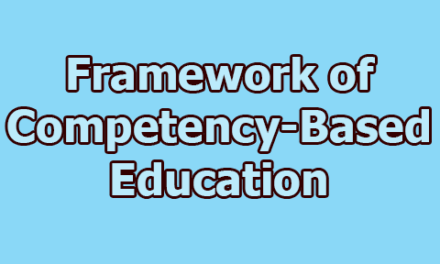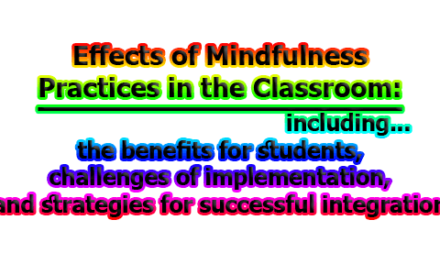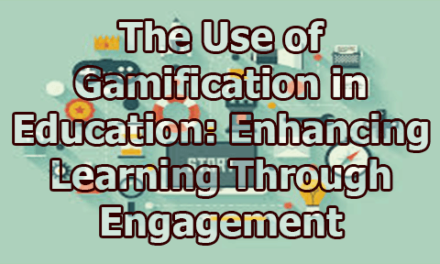Importance and Components of Critical Thinking:
Critical thinking is the compass that guides our intellectual journey through the complex landscape of information, ideas, and challenges. It is the cognitive toolset that empowers individuals to dissect, assess, and synthesize information, ultimately leading to informed decisions and innovative solutions. As we navigate an increasingly interconnected and dynamic world, the significance of critical thinking becomes ever more pronounced. In this age of information overload, understanding the components of critical thinking and recognizing their paramount importance is essential for not only personal growth but also for addressing the multifaceted issues that shape our society and the global community. In the rest of this article, we will explore the importance and components of critical thinking.
Importance of Critical Thinking:
Critical thinking is an indispensable skill that plays a pivotal role in numerous aspects of our lives, offering a multifaceted set of benefits that extend far beyond the realm of academia. It serves as a cornerstone for rational discourse, informed decision-making, and navigating the complexities of our ever-evolving world. Here are the importance of critical thinking:
1. A Foundation for Informed Decision-Making: Critical thinking provides a robust foundation for informed decision-making (Ennis, 1987). By systematically assessing information, individuals can discern credible sources from unreliable ones and distinguish facts from opinions (Facione, 1990). This discernment empowers individuals to make well-informed decisions in personal, academic, and professional contexts (Halpern, 1998). For instance, when evaluating competing medical treatments, critical thinkers are better equipped to assess the quality of research studies and choose the most effective treatment (Stanovich, 2013).
2. Effective Communication and Expression: Effective communication is contingent upon critical thinking skills (Paul & Elder, 2001). Critical thinkers are adept at articulating thoughts, ideas, and arguments clearly and persuasively (Van Gelder, 2005). Their ability to critically assess their own perspectives and those of others facilitates productive discussions (Bailin, 2002). This skill is invaluable in personal relationships, workplace dynamics, and public discourse (Kurland, 2000).
3. Adaptation in a Rapidly Changing World: In a world characterized by rapid change, adaptability is essential (Costa & Kallick, 2008). Critical thinking enables individuals to analyze new information, assess its relevance, and adapt their thinking and actions accordingly (Paul & Elder, 2006). This adaptability is vital for remaining competitive in the job market and responding to evolving societal and technological landscapes (Beyer, 2012).
4. Fostering Innovation and Creativity: Critical thinking is a catalyst for innovation and creativity (Kim, 2011). By encouraging individuals to challenge conventional wisdom and explore alternative viewpoints, it stimulates creative thinking (Sternberg, 2003). This creative thinking leads to innovative solutions to complex problems, driving progress in diverse fields, from technology to the arts (Paul & Elder, 2001).
5. Personal Growth and Self-Reflection: Engaging in critical thinking often results in personal growth and self-reflection (McPeck, 1990). It encourages individuals to examine their beliefs, values, and biases, fostering intellectual humility and openness to personal development (Paul & Elder, 2006). This self-awareness is a fundamental component of emotional intelligence and personal well-being (Matthews, Zeidner, & Roberts, 2002).
6. Critical Thinking in the Global Context: Critical thinking holds significant importance in a global context (Paul & Elder, 2014). It enables individuals to appreciate diverse perspectives and navigate complex global issues (Sperber, 2010). Whether in international diplomacy, business negotiations, or humanitarian efforts, the ability to think critically about global challenges is paramount for effective problem-solving (Brookfield, 2012).
Components of Critical Thinking:
Critical thinking comprises various interconnected components, including:
1. Analysis: Analysis is a foundational component of critical thinking, encompassing the ability to break down complex issues into smaller, manageable parts for in-depth examination (Brookfield, 2011). This process involves dissecting a problem or situation, identifying its constituent elements, and understanding the relationships among them (Ennis, 1987).
The analysis enables critical thinkers to deconstruct multifaceted problems and explore the underlying factors that contribute to their complexity (Paul & Elder, 2006). By decomposing complex issues into simpler components, individuals gain a clearer understanding of the problem’s nuances and can formulate more effective strategies for addressing it (Facione, 2015).
2. Evaluation: The component of evaluation is integral to critical thinking, emphasizing the capacity to assess the quality, relevance, and credibility of information and arguments (Halpern, 2010). In the evaluation process, individuals consider multiple factors, such as the source of information, the context in which it is presented, and the presence of bias or fallacies (McPeck, 1990).
Evaluation is crucial for distinguishing reliable, evidence-based information from unreliable or biased sources (Paul, 1992). It helps individuals make informed judgments about the trustworthiness and accuracy of data and arguments, thereby reducing the risk of accepting misleading or erroneous information (Browne & Keeley, 2014).
3. Inference: Inference, another vital component of critical thinking, involves drawing logical conclusions from available evidence and facts (Bailin et al., 1999). This cognitive process requires synthesizing information, making connections between data points, and forming well-reasoned judgments or hypotheses (Lipman, 1988).
Inference skills enable individuals to go beyond surface-level understanding and derive meaningful insights from the information at hand (Paul & Nosich, 1993). By identifying patterns, cause-and-effect relationships, and implications, critical thinkers can make informed decisions and predictions based on a solid foundation of reasoning (Nodding, 2005).
4. Problem-Solving: Critical thinking’s practical application often manifests in problem-solving, which entails using analytical and creative thinking to identify, define, and address real-world problems (Facione & Facione, 2007). Problem-solving involves a systematic approach, including problem identification, solution generation, and implementation planning (Dewey, 1933).
Critical thinkers approach problem-solving by considering various perspectives, generating multiple potential solutions, and evaluating their feasibility and effectiveness (Elder & Paul, 2006). This component equips individuals with the skills needed to tackle complex challenges methodically and arrive at well-considered solutions (Perkins & Murphy, 2006).
5. Decision-Making: Decision-making is closely linked to problem-solving but focuses on choosing the most appropriate course of action from among multiple alternatives (Baron, 2008). In critical thinking, decision-making relies on a well-reasoned analysis of available information, which includes weighing the pros and cons of each option and considering potential consequences (Janis & Mann, 1977).
Critical thinkers make decisions based on both rational analysis and ethical considerations, ensuring that choices align with desired outcomes and ethical principles (Facione & Gittens, 2013). Effective decision-making, a hallmark of critical thinking, leads to informed and thoughtful choices in personal, professional, and societal contexts (Tversky & Kahneman, 1981).
6. Creativity: Although less overt, creativity plays a significant role in critical thinking by encouraging individuals to explore unconventional ideas and seek innovative solutions (Cropley, 2006). Critical thinkers employ creativity to expand their problem-solving toolkit and challenge established norms (Paul, 1995).
Creativity in critical thinking involves thinking beyond traditional boundaries, fostering a willingness to take risks, and generating novel ideas (Sternberg, 2003). By incorporating creative thinking into their approach, critical thinkers can uncover unique solutions to complex problems, contributing to innovation and progress (Amabile, 1983).
In conclusion, in a world characterized by rapid change and complexity, critical thinking stands as the cornerstone of intellectual prowess and effective problem-solving. Its components—analysis, evaluation, inference, problem-solving, decision-making, and creativity—interact harmoniously to cultivate individuals who can navigate the challenges of today and envision a better tomorrow. Embracing and nurturing critical thinking skills is not merely a pursuit of academic excellence; it is a commitment to shaping a more informed, innovative, and resilient world. As we foster these skills in ourselves and future generations, we embark on a journey towards a brighter and more intellectually vibrant future, where the power of critical thinking brightens the path forward.
References:
- Bailin, S. (2002). Critical Thinking and Science Education. Science & Education, 11(4), 361-375.
- Bailin, S., Case, R., Coombs, J. R., & Daniels, L. B. (1999). Common misconceptions of critical thinking. Journal of Curriculum Studies, 31(3), 269-283.
- Beyer, B. K. (2012). Critical Thinking: What Is It? Social Education, 56(7), 392-394.
- Baron, J. (2008). Thinking and deciding (4th ed.). Cambridge University Press.
- Brookfield, S. D. (2012). Teaching for Critical Thinking: Tools and Techniques to Help Students Question Their Assumptions. John Wiley & Sons.
- Browne, M. N., & Keeley, S. M. (2014). Asking the right questions: A guide to critical thinking (11th ed.). Pearson.
- Costa, A. L., & Kallick, B. (2008). Learning and Leading with Habits of Mind: 16 Essential Characteristics for Success. ASCD.
- Cropley, A. J. (2006). In praise of convergent thinking. Creativity Research Journal, 18(3), 391-404.
- Dewey, J. (1933). How we think: A restatement of the relation of reflective thinking to the educative process. Heath.
- Elder, L., & Paul, R. (2006). Critical thinking: The nature of critical and creative thought. Journal of Developmental Education, 30(2), 34-35.
- Ennis, R. H. (1987). A Taxonomy of Critical Thinking Dispositions and Abilities. In J. Baron & R. Sternberg (Eds.), Teaching Thinking Skills: Theory and Practice (pp. 9-26). Freeman.
- Facione, P. A. (1990). Critical Thinking: A Statement of Expert Consensus for Purposes of Educational Assessment and Instruction. Research Findings and Recommendations. California Academic Press.
- Facione, P. A. (2015). Critical thinking: What it is and why it counts. Insight Assessment.
- Facione, P. A., & Facione, N. C. (2007). Critical thinking assessment: Current status and issues. In D. F. Halpern, & M. D. Millar (Eds.), Necessary conditions for assessment (pp. 33-47). Lawrence Erlbaum Associates.
- Facione, P. A., & Gittens, C. A. (2013). Think critically (3rd ed.). Pearson.
- Halpern, D. F. (1998). Teaching Critical Thinking for Transfer across Domains: Dispositions, Skills, Structure Training, and Metacognitive Monitoring. American Psychologist, 53(4), 449-455.
- Halpern, D. F. (2010). Halpern’s critical thinking assessment predicts real-world outcomes of critical thinking. Applied Cognitive Psychology, 24(5), 713-721.
- Janis, I. L., & Mann, L. (1977). Decision making: A psychological analysis of conflict, choice, and commitment. Free Press.
- Kim, K. H. (2011). The Creativity Crisis: The Decrease in Creative Thinking Scores on the Torrance Tests of Creative Thinking. Creativity Research Journal, 23(4), 285-295.
- Kurland, D. J. (2000). What is Critical Thinking? The Critical Thinking Community. https://www.criticalthinking.org/pages/what-is-critical-thinking/766
- Lipman, M. (1988). Critical thinking—what can it be? Educational Leadership, 46(1), 38-43.
- Matthews, G., Zeidner, M., & Roberts, R. D. (2002). Emotional Intelligence: Science and Myth. MIT Press.
- McPeck, J. E. (1990). Critical Thinking and Education. St. Martin’s Press.
- McPeck, J. E. (1990). Critical thinking and subject specificity: A reply to Ennis. Educational Researcher, 19(4), 10-12.
- Nodding, N. (2005). Critical thinking: What can it be? Educational Leadership, 53(2), 6-11.
- Paul, R. (1992). Critical thinking: What, why, and how. New Directions for Community Colleges, 1992(77), 3-24.
- Paul, R. (1995). Critical thinking: How to prepare students for a rapidly changing world. Foundation for Critical Thinking.
- Paul, R., & Elder, L. (2006). Critical thinking: The nature of critical and creative thought. Journal of Developmental Education, 30(2), 34-35.
- Perkins, D. N., & Murphy, E. (2006). Identifying and measuring individual engagement in critical thinking in online discussions: An exploratory case study. Educational Technology Research and Development, 54(2), 115-145.
- Sperber, D. (2010). Reasoning as Simulation. Behavioral and Brain Sciences, 34(4), 272-273.
- Stanovich, K. E. (2013). How to Think Straight about Psychology (10th ed.). Pearson.
- Sternberg, R. J. (2003). Wisdom, Intelligence, and Creativity Synthesized. Cambridge University Press.
- Tversky, A., & Kahneman, D. (1981). The framing of decisions and the psychology of choice. Science, 211(4481), 453-458.
- Van Gelder, T. (2005). Teaching Critical Thinking: Some Lessons from Cognitive Science. College Teaching, 53(1), 41-48.

Assistant Teacher at Zinzira Pir Mohammad Pilot School and College

